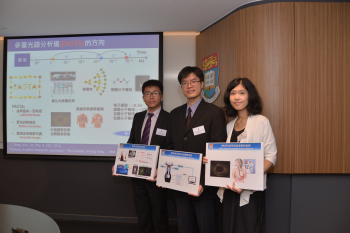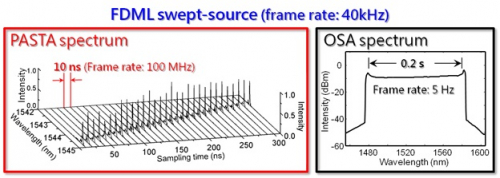Media
Up to one million times faster than existing technology
HKU advances new optical spectroscopy technology PASTA
for breakthroughs in clinical and pathological diagnosis and smart green engine development
18 Sep 2014
(from left) Dr. Kenneth Wong Kin-Yip of the Department of Electrical and Electronic Engineering, Dr. Nikki Lee of the Department of Surgery, and Dr. Zhang Chi of of the Department of Electrical and Electronic Engineering. On screen is image of a mouse' s oesophagus segment captured using PASTA technology
Spectroscopy is widely used in our daily life by analyzing and differentiating chemical signatures of different substances. For example, it can be used in quality monitoring for food safety such as, in recent instances of illegal cooking oil, analyzing the chemical composition of the oil and toxic substances; breath testing of the alcohol concentration on the suspected drunken driver; real-time monitoring of the concentrations on various greenhouse gases or industrial toxic gas emissions in the atmosphere.
In a multi-disciplinary research project led by the Faculty of Engineering, the University of Hong Kong (HKU) has successfully developed a new optical spectroscopy approach which integrates existing fiber-optic and laser technologies, called Parametric Spectro-Temporal Analyzer (PASTA) that can capture optical spectrum of dynamic events up to 1,000,000 times faster than existing optical spectrum analyzer technologies. This achieves unprecedentedly fast, more accurate and more efficient optical spectroscopy of ultrafast dynamic events and will certainly beneficial in wide range of advanced applications. The results have been reported in various prestigious journals including the Nature Scientific Reports (June edition), Optics Express, and Applied Physics Letters; and shared with fellow scientists in international academic forums.
 PASTA technology can potentially be used in real-time ultrafast monitoring on the combustion status in industrial application.
PASTA technology can potentially be used in real-time ultrafast monitoring on the combustion status in industrial application.The PASTA technology, together with the state-of-art optical endoscopic imaging technology (namely optical coherence tomography, OCT), can analyze massive data in a short period of time and can thus improve the accuracy and stability of in vivo imaging, which enables endoscopic application and real-time monitoring during the minimal invasive surgery. Since current clinical and pathological diagnosis requires taking the biopsy from the human body, while coupling the endoscope together with this novel PASTA technology enables the real-time, non-invasive observation, and helps the detection and diagnosis of early lesions. In regards to industrial application, this technology can potentially be used in real-time ultrafast monitoring on the combustion status of the chemical reactions so as to optimize the combustion engine efficiency and help in developing the next generation smart green engines.
The research group is led by Dr. Kenneth Wong Kin-Yip, Associate Professor of the Department of Electrical and Electronic Engineering, with members including Research Associate Dr. Zhang Chi of the same department, and Dr. Nikki Lee, Assistant Professor of the Department of Surgery, Li Ka Shing Faculty of Medicine.
Their developed PASTA technology achieves unprecedentedly fast, more accurate and more efficient optical spectroscopy of ultrafast dynamic events.
Traditionally, spectroscopy is used for analyzing and differentiating chemical signatures of different substances for various applications ranging from chemical/medical diagnostics based on quantitative analysis without grasping the morphological features. When incorporated with PASTA, it will become a valuable tool for capturing the optical spectrum of different substances in an ultrafast manner with high accuracy and efficiency. This technology can capture optical spectra of the ultrafast-dynamic phenomena (such as combustion inside the jet engines) with optical resolution at 0.02 nm at a scan rate as fast as 100,000,000 per second, and is 1,000,000 times faster than conventional optical spectrum analyzer technologies. Moreover, together with the state-of-art optical imaging technology (namely optical coherence tomography, OCT), it can analyze massive data in a short period of time and can thus improve the accuracy of in vivo imaging, which enables real-time monitoring during the minimal invasive surgery. As regards industrial application, this technique can potentially be used in optimizing combustion engine efficiency and observing ultrafast chemical reactions.
Dr. Kenneth Kin-Yip Wong pointed out that, this new technology will certainly be beneficial in observing microscopic and spectroscopic imaging for a wide range of biomedical applications including but not limited to tumor detection and diagnosis, and assisted surgery. He said: “Biomedical and Health Technologies have been identified as one of the strategic research areas of the Faculty of Engineering, HKU. Over the past few years, we have been undertaking researches in Electrical and Electronic Engineering, particularly in biophotonic imaging technologies. PASTA is one of the key technologies developed in our group that provides the best combination of high-resolution and high-speed spectroscopic imaging. Realizing such capability has been challenging, yet mandated for in vivo real-time imaging during surgery and basic research in life sciences. For example, existing imaging technologies are unable to provide real-time microscopic and spectroscopic image and video during surgery. PASTA is especially pertinent to observing ultrafast dynamic spectroscopic events and also promising for in vivo real-time imaging that requires ultrafast scan rate. These will also be the main focus of our on-going research with this new technique.”
Dr. Nikki Lee added: “PASTA is an important advance in imaging technology that enables medical professions to access both in vivo microscopic and spectroscopic information in ultrafast speed during the surgery and other medical procedures including endoscopy. Given the critical time nature and inevitable human motions, this technology can facilitate identification of essential real-time information more accurately and efficiently. The development and application of PASTA holds great assistance and promise for biomedical diagnostics and assisted surgery in the future.”
The imaging speed of parametric spectro-temporal analyzer (PASTA) (left) in capturing ultrafast FDML swept-source with 100 millions spectra per second, much faster than 5 spectra per second of the existing optical spectrum analyzer (OSA) (right).
For media enquiries, please contact:
HKU Communication & Public Affairs Office Ms Trinni Choy (tel: 2859 2606 email: pychoy@hku.hk); Ms Melanie Wan (tel: 2859 2600 email: melwkwan@hku.hk) ; or HKU Faculty of Engineering Ms Joya Shum (tel: 2859 1924 email: joya.shum@hku.hk).



